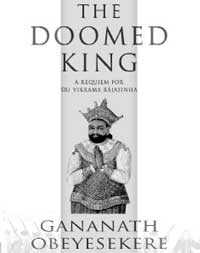Monday Mar 17, 2025
Monday Mar 17, 2025
Saturday, 6 July 2019 00:00 - - {{hitsCtrl.values.hits}}
The turn of the 19th century was a fascinating time of historical change for the world at large and Sri Lanka in particular. The Dutch East India Company (VOC) which ruled over Indonesia and controlled Lanka’s maritime provinces was in decline. British colonial expansion was on the rise, replacing the Honourable East India Company’s stranglehold on India. Under Governor Frederick North, the British had already set up shop in Mannar to exploit the pearl fisheries. In 1798, North, at age 32, was appointed Governor of Ceylon while Sri Vikrama Rajasinghe, at age 16, was consecrated King of Kandy – or Ceylon. 
While Britain ruled the seas, the only threat to British domination of the world came, unexpectedly, from the French. The French revolution resulted in internal chaos leaving France’s allies in disarray. Under threat from Britain’s navy, Napoleon, who ascended to First Consul in 1799, quickly established military rule and a stable economy, warred against Britain and her allies, and became powerful enough to force a peace accord known as the treaty of Amiens.
Britain’s representative, the Marquess of Cornwallis, and Joseph Bonaparte, the emperor’s brother, divided up choice bits of the world, while further down the table, the Dutch representative Schimmelpenninck ceded Ceylon’s maritime provinces to Britain. However lucrative, pearl fishing is seasonal and before long, Governor North began to wonder why Britain didn’t rule the entire island, rather than just its coastal areas. As might be expected, he sent in troops to capture Kandy, but his attempt was bloodily repulsed.
Realistically, given the way the world was moving, Ceylon couldn’t have remained sovereign for long. Sooner or later, by fair means or foul, Ceylon would have fallen into the hands of yet another European power. An insidious campaign was launched to discredit the Lankan king by painting him in a bad light and with the native population clamouring to be free from his rule, the British could magnanimously and legitimately liberate the island from tyranny.
Clever spies like John D’Oyly learned the Sinhala of the Sinhalese, and the British won the hearts and minds of Sinhala aristocracy with promises of power and before you knew it the king was deposed, ostensibly by his nobles who signed the Kandyan Convention, deposing the king and effectively ceding the kingdom’s territory to British Rule, ending over 2,000 years of sovereignty. Like they say, nothing changes and given today’s politics, yesterday’s machinations are not hard to understand.
Obeysekere shines a new light on that part of our history by examining Kadaimpoth, Vittipoth and documents from English servicemen to reveal a king who was much maligned and betrayed by those he trusted. We see how the British and the king’s nobles colluded to bring about his downfall.
The Kandyan surrender remains unusual in that the treaty was signed by nobles and dignitaries of the kingdom rather than the overthrown monarch himself. In an ironical twist, Rajasinghe was exiled and packed off to Vellore on the Corwallis, named after the Marquess who acquired Lanka’s maritime provinces by treaty rather than by war.
Although one might believe that history teaches lessons that will enable us to avoid political pitfalls, our personal prejudices seem to lock us into a behavioural pattern that remains unchanged for over two hundred years, proving that in these circumstances, nature triumphs over nurture.
(Sam Perera is a partner of the Perera-Hussein Publishing House which publishes culturally relevant stories by emerging and established Lankan and regional authors – for a primarily Lankan audience. Ph books are available everywhere books are sold and through www.pererahussein.com)
THE DOOMED KING – history
By Prof. Gananath Obeysekere
Sailfish, an imprint of the Perera-Hussein Publishing House, Rs. 1,500Available in all bookshops from Barefoot to Vijitha Yapa and www.pererahussein.com
Discover Kapruka, the leading online shopping platform in Sri Lanka, where you can conveniently send Gifts and Flowers to your loved ones for any event including Valentine ’s Day. Explore a wide range of popular Shopping Categories on Kapruka, including Toys, Groceries, Electronics, Birthday Cakes, Fruits, Chocolates, Flower Bouquets, Clothing, Watches, Lingerie, Gift Sets and Jewellery. Also if you’re interested in selling with Kapruka, Partner Central by Kapruka is the best solution to start with. Moreover, through Kapruka Global Shop, you can also enjoy the convenience of purchasing products from renowned platforms like Amazon and eBay and have them delivered to Sri Lanka.
Discover Kapruka, the leading online shopping platform in Sri Lanka, where you can conveniently send Gifts and Flowers to your loved ones for any event including Valentine ’s Day. Explore a wide range of popular Shopping Categories on Kapruka, including Toys, Groceries, Electronics, Birthday Cakes, Fruits, Chocolates, Flower Bouquets, Clothing, Watches, Lingerie, Gift Sets and Jewellery. Also if you’re interested in selling with Kapruka, Partner Central by Kapruka is the best solution to start with. Moreover, through Kapruka Global Shop, you can also enjoy the convenience of purchasing products from renowned platforms like Amazon and eBay and have them delivered to Sri Lanka.